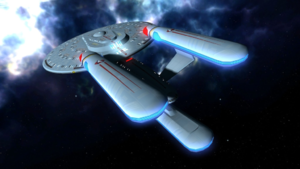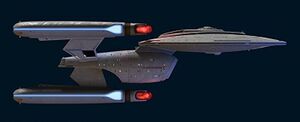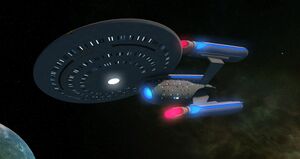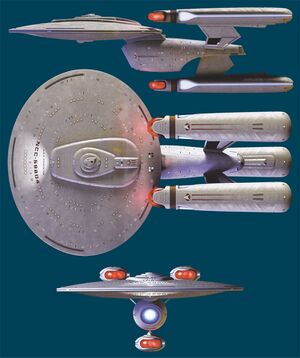Difference between revisions of "Niagara Class"
CrimsonTacit (talk | contribs) |
m |
||
| Line 2: | Line 2: | ||
{{Specification | {{Specification | ||
| image = [[Image:Niagara1.png]] | | image = [[Image:Niagara1.png]] | ||
| | | catName = Niagara | ||
| name = Niagara | | name = Niagara | ||
| affiliation = [[United Federation of Planets]] | | affiliation = [[United Federation of Planets]] | ||
| Line 47: | Line 47: | ||
| msd = | | msd = | ||
| playable = yes | | playable = yes | ||
| bfmsRegistry = https://bravofleet.com/registry?_status=&_class=105807&_sort=namesake&_per_page=100 | |||
}}The '''Niagara-class fast cruiser''' is an exceptionally fast but also exceptionally odd starship, dating to the 2340s. Developed as a larger and more capable successor to the [[Constellation Class|''Constellation''-class fast cruiser]], its current configuration shows commonality with both the [[Ambassador Class|Ambassador-class heavy cruiser]] and the [[Galaxy Class|''Galaxy''-class explorer]], thanks to a refit in the early 2360s. While the initial design specifications called for simply a smaller, more efficient version of the ''Ambassador'', in practice, these ships' unique engine configuration has made them difficult to operate and they didn't receive a large production run. While Starfleet began to convert them for Auxiliary service in 2400, this decision was reversed following the disastrous impacts of Frontier Day 2401, and this class is re-entering mainline service with the upgrades necessary to serve in the 25th-century Starfleet. | }}The '''Niagara-class fast cruiser''' is an exceptionally fast but also exceptionally odd starship, dating to the 2340s. Developed as a larger and more capable successor to the [[Constellation Class|''Constellation''-class fast cruiser]], its current configuration shows commonality with both the [[Ambassador Class|Ambassador-class heavy cruiser]] and the [[Galaxy Class|''Galaxy''-class explorer]], thanks to a refit in the early 2360s. While the initial design specifications called for simply a smaller, more efficient version of the ''Ambassador'', in practice, these ships' unique engine configuration has made them difficult to operate and they didn't receive a large production run. While Starfleet began to convert them for Auxiliary service in 2400, this decision was reversed following the disastrous impacts of Frontier Day 2401, and this class is re-entering mainline service with the upgrades necessary to serve in the 25th-century Starfleet. | ||
== Science and Exploration == | == Science and Exploration == | ||
Revision as of 16:14, 15 July 2024
The Niagara-class fast cruiser is an exceptionally fast but also exceptionally odd starship, dating to the 2340s. Developed as a larger and more capable successor to the Constellation-class fast cruiser, its current configuration shows commonality with both the Ambassador-class heavy cruiser and the Galaxy-class explorer, thanks to a refit in the early 2360s. While the initial design specifications called for simply a smaller, more efficient version of the Ambassador, in practice, these ships' unique engine configuration has made them difficult to operate and they didn't receive a large production run. While Starfleet began to convert them for Auxiliary service in 2400, this decision was reversed following the disastrous impacts of Frontier Day 2401, and this class is re-entering mainline service with the upgrades necessary to serve in the 25th-century Starfleet.
Science and Exploration
Diplomacy
Engineering
In the 2360s, the class was being evaluated for possible retirement in favor of the designs developed as part of the Fleet Modernization Program, but their basic spaceframes were considered too young to be discarded, even if their performance wasn't spectacular. Instead of retiring them, it was decided to replace their nacelles with the design used aboard the Galaxy and Nebula classes, as well as to upgrade their tactical systems. The resulting design is still quite awkward--the shape of the ship was optimized for a three-nacelle design, and so the refit needed to retain the third nacelle--but with these advanced engines, the ship is capable of comfortably cruising at Warp 8 (compared to the design cruise speed of the Galaxy being a mere Warp 6) and sprinting to Warp 9.9, which makes them one of the fastest cruiser designs in service even as of the start of the 25th century.
This speed comes at a cost, though, as the engine systems are difficult to maintain, especially considering that the number of engineers with experience operating tri-nacelle designs is extremely small. Structural integrity systems and the inertial dampeners aboard the ship are also complex and non-standard to handle the unusual stress loads created by the engines. Otherwise, the systems aboard this ship are pretty standard for the mid-24th century.
The Niagara's physical structure resembles the Ambassador but at a smaller scale, being roughly half the size of the larger ship. The design has a large shuttle bay on the stern, which can carry cargo shuttles or runabouts for use in humanitarian missions.
Tactical
Niagara-class starships are well-armed for their size, though they lack the armored hulls of later classes. This ship was designed with Type-IX phaser arrays, and in the 2360s, its weapons systems were upgraded to incorporate the new Type-X arrays, a total of 13 of them. These offered comprehensive phaser coverage with few blind spots. Torpedo coverage is fired by four class-six single-fire launchers, two forward above the deflector and two aft under the shuttle bay.
While primarily intended for humanitarian response duties, the Niagara is also capable of being a first response vessel to answer distress calls, which often involve combat situations. This is particularly true of members of this class stationed in frontier areas, where they are quite adept at striking against pirates. During the Dominion War, ships of this class were used to find and retrieve escape pods from destroyed ships, using their superior speed to quickly jump away from the battle and return the pods to forward staging points or starbases where their occupants could be evaluated and treated. This made them appealing targets to the Jem'Hadar, who targeted them to inflict morale damage on Starfleet.
As of the 2400s, a Niagara-class vessel would be a poor choice for a purely tactical mission, as her weapons and shields are at least two generations behind the current Starfleet standard. Her speed does allow her to perform well in reconnaissance roles, however.
Shipboard Life
Firmly a modern design as a post-Ambassador class of starship, the Niagara is an aging workhorse with very limited amenities compared to larger ships. In mainline service, they had two holodecks which were converted from cargo bays in the latter half of the 24th century, as well as comfortable lounges intended to double as diplomatic entertaining spaces. The size of the crew was generally small enough versus the size of the ship that not even the most junior crewmen had to share a bedroom, just a living room, and head. This made them relatively popular assignments on their own, even though they don't get the most exciting missions.
Tours of duty aboard the Niagara tend to be relatively short for command, science, and tactical personnel, as proving their competence here generally gets them transferred to a more important ship. For engineers, though, it's possible to fall into the Niagara trap or to "go over the falls," as developing proficiency with the three-nacelle design makes it highly likely that you will spend a large amount of your career on these aging, maintenance-intensive ships. As "third nacelle" is the 24th century equivalent to the phrase "third wheel," meaning someone who is supernumerary or otherwise surplus to requirements, members of Starfleet who have never served on one of these ships tend to look down on them, which has created a sort of reflexive pride in the Niagara class for their crews. Indeed, they are now so rare that some officers consider them to be a myth.
Niagara class History
Envisioned as early as the 2330s, when the first Ambassador-class heavy cruisers were rolling off of the assembly lines as a complement to the larger ship with a smaller hull and simpler systems in the same way that the Miranda functioned to the Constitution, the Niagara-class design process took nearly ten years. During that time, Starfleet's requirements shifted many times, and it was not considered an urgent project due to the Miranda, Constellation, and Excelsior classes comfortably handling Starfleet's needs through the 2340s. A brain wave by the lead designer was to experiment with new engine configurations on this design, and he was given tentative but skeptical permission to try reviving the tri-nacelle design pioneered aboard the Federation-class dreadnought of the 2260s.
The prototyping phase was extensive, and the construction of the Niagara took longer than usual, with the ship not leaving the yards until 2345. It was considered a successful ship, as it had pretty good top speeds and modern tactical and computing systems, but the complexity of the design precluded it from mass production, though it found its niche as a successor to the Constellation for fast delivery of supplies. Starfleet investigated reconfiguring the design for two nacelles, but this would have required reworking the structure of the ship and the warp core--all design time that might push the ship back another decade. As such, a small order of 40 ships was made, and Starfleet was content to let this be a strange, limited-run design until the Fleet Modernization Program could be implemented.
In the 2350s, the last vessel of this class left the yards. The following decade, Starfleet considered scrapping them, but they were otherwise happy with the spaceframe, and since they no longer were going to build more anyway, it was decided to leave them in service. The Starfleet Corps of Engineers implemented a program to replace their nacelles with Galaxy-type nacelles, however, which raised their middling speeds to the very fast design they now have.
The increased top speed of this ship allowed it to go from a generalist light cruiser to a fast response and courier design. These ships were just settling into that role when the Princeton was destroyed at the Battle of Wolf 359. This would be the first in a long list of hull losses for the class, which would pick up during the Dominion War the next decade. Because of their high speed, Starfleet used them to move essential contingents of security personnel, weapons, and supplies to vulnerable border worlds, which made them attractive targets. During large battles, they were also used to pick up escape pods and take them back to safe zones, which further put a target on their backs. During the course of the war, two dozen of these ships were destroyed, leaving only 15 in service by the 2370s. Despite their losses, they were also credited with saving thousands of personnel, and their logistical support functions had immeasurable impacts in the war.
Starfleet once again considered retiring the class after the war and actually started the process for a handful of the older members of the class, but the evacuation effort of Romulus starting in 2381 ensured that they would remain in service. The class was officially retired in 2400, with the remaining units being disarmed and transferred to the Starfleet Auxiliary, where they continued on as fast transports and ambulance ships. This decision was reversed, following heavy losses of Frontier Day 2401, and the Niagara is re-entering service alongside the Ambassador, with minor updates to its computers and other systems to make it capable of serving in a new era.
Niagara class In-Play
- Three-nacelle designs are very rare, and this is both due to Gene Roddenberry declaring that Starfleet ships *had* to have even numbers of warp engines and because they just look weird. This seems to be an in-universe perception as well, with the phrase "third nacelle" being used on the show to refer to someone who's third-wheeling.
- This is a rare, aging design that still has its strengths (it's very fast) but which is so unusual that many officers might not even know it exists.
- A fast cruiser is a starship that's mainly intended to deliver very important supplies for engineering or humanitarian projects, but which may also find itself responding to distress calls.
- If you're an engineer, you might wish you had had the chance to serve on such a fascinating and unique starship.



